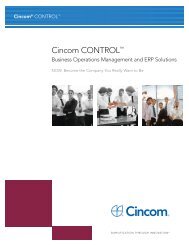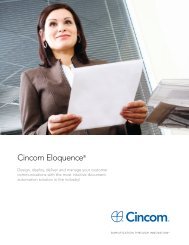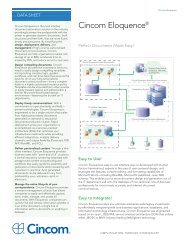Thales Underwater Systems Case Study - Cincom
Thales Underwater Systems Case Study - Cincom
Thales Underwater Systems Case Study - Cincom
You also want an ePaper? Increase the reach of your titles
YUMPU automatically turns print PDFs into web optimized ePapers that Google loves.
Goals:• Take ERP in-house to reducecosts, improve security, andextend ERP benefits• Coordinate front- and back-officeoperations• Support a model of continuousbusiness development• Improve access to informationfrom around the organisationChallenge:• Integrate financials across anorganisation of five business lines• Manage engineering requirementsemerging from continuousproduct improvements• Meet a rapidly encroachingdeadlineProfile in Success: <strong>Thales</strong> <strong>Underwater</strong> <strong>Systems</strong>Benefits from <strong>Cincom</strong>’s ERPSolution Echo Even to SonarManufacturer’s Back Office<strong>Cincom</strong> raises the bar on flexibility, integration, andfuture functionality at <strong>Thales</strong> <strong>Underwater</strong> <strong>Systems</strong>Solution:<strong>Cincom</strong> CONTROL andCONTROL FinancialsKey Results:• Full implementation and trainingin nine months• Improved decision-making andreporting capabilities• Streamlined financial operations• Better communication acrossdepartments• New capabilities to address futureopportunitiesSituation: <strong>Thales</strong> <strong>Underwater</strong> <strong>Systems</strong> was created in 1996 with themerging of Thomson Sintra Pacific and the sonar activities of GEC-Marconi. With a turnover of more than AUD$110 million, the Sydneybasedengineering and manufacturing company employs more than500 people in designing and manufacturing underwater sonarequipment for defence, and such civilian applications as offshore oilexploration.Although TUS had previously outsourced its Enterprise ResourcePlanning (ERP) system to a service provider, they now wanted to takethe system in-house, but with full functionality, and before the yearwas out.
“The initial catalyst was Y2K compliance,” said PeterQuinlan, Operations Director for TUS. “The ERPoutsourced to the service provider was not compliant,and we felt improvements to that system would beexcessively costly and not a good investment anyway,as the system had other limitations.”Moreover, TUS needed to blend its back-office activitieswith those in the rest of the organisation. Linkageamong various TUS units would give its financial staff abetter picture of the organisation’s overall performanceand allow them to create more meaningful reports.Beyond these strategic motives, TUS wanted to reducethe cost of ownership, improve security and extend theERP benefits.On the financials side of the business, ManagementAccountant Troy Vegvari had known the difficulties inpreparing reports with outdated information. Plus, “wealso wanted something that would enable us to continuedoing our current activities, while at the same timeallowing for future uses. And we wanted something thatwould give us an easy path to information from aroundthe organisation,” Mr. Vegvari said. “Extractinginformation from our previous system was cumbersomeand it needed a great deal of IT administration.”Enter <strong>Cincom</strong><strong>Cincom</strong> approached TUS in 1999, just as the companywas choosing an ERP provider from a short list of othermajor vendors. “By the time we talked to <strong>Cincom</strong> aboutbringing the ERP in-house … we were highly educated,sceptical customers,” said Mr. Quinlan.“Ours is not a conventional manufacturing operation,”explained Mr. Quinlan. “We manufacture very complexproducts and we approach each product as a miniprojectin itself. We might work on up to 100 projects, ofvarying scale, at any one time and these are spreadbetween five separate business lines. To some extent,these business lines operate as sub-businesses in theirown right, with their own personnel, resources andbudgets.”Besides anticipating 2000, TUS identified four mainreasons to change the ERP system and bring it in-house:• A more cost-effective solution that ended itsdependence on an outside service• Security enhancement by taking the system in-house• An end to the “islands of information” that resultedfrom disparate business systems• More accessible and timely analysis of information“We always need to get the maximumperformance out of our very high-techproducts, and that can mean frequenthigh-tech change, often on a large scale.”Rapid implementation was imperative to beat theimmovable Y2K deadline. Strategically, the companysought increased capability to support new initiativesand continuous improvement of its business processes.Engineering change control was another concern. “Ourcustomers expect us to improve our productscontinuously,” explained Mr. Quinlan. “We always needto get the maximum performance out of our very hightechproducts and that can mean frequent high-techchange, often on a large scale.” The new ERP systemhad to be flexible enough to support the culture ofchange that arises from constantly looking for ways toimprove products. This meant coping with unusuallydeep bills of materials and with complex tracking ofserial numbers of the numerous components withinproducts – two capabilities offered by <strong>Cincom</strong>CONTROL.Finally, “We do a monthly close, with our reports outputby the fourth working day, with the next two days formanagement reports,” said Mr. Vegvari. “Previouslymost of this time would be spent compiling thereports.”“An Hour of Hell”Giving the <strong>Cincom</strong> representatives one hour to acquitthemselves, Mr. Quinlan was impressed by thecompany’s obvious understanding of his business needsand its experience in handling complicated aerospaceand defence industry operations.“I gave <strong>Cincom</strong> an hour of hell at that meeting, but theydemonstrated real knowledge of this type of business,”said Mr Quinlan. “They made it clear their productwould work for us.”Co-ordinating the design and technical implementationof the ERP system for TUS was Business <strong>Systems</strong>Manager Malcolm Boadle. For Mr. Boadle, the key toensuring that the ERP was both functional and usedwidely was by having personnel responsible for the keybusiness areas take ownership throughout the selectionand implementation process.“Our team of ‘shirt-sleeves managers’ knew they had avested interest in making sure the system met theirparticular requirements,” Mr. Boadle said. “They weretasked with satisfying themselves that the system wouldhelp execute their particular duties and effectively runour business.”Mr. Vegvari summarized the decision: “When we wereconducting our technology assessments, we looked at anumber of systems, including SAP ® and Oracle ® . Wechose <strong>Cincom</strong> because of its price and the package ofcapabilities it offered, and the fact that it best suited ourbusiness requirements. It was also reassuring to knowthat other businesses in similar areas to us were using<strong>Cincom</strong>.”
CINCOM, CONTROL, CONTROL:Financial, and the Quadrant Logo areregistered trademarks of <strong>Cincom</strong> <strong>Systems</strong>, Inc.SAP is a registered trademark of SAP AG. Oracle is a registered trademarkof Oracle Corporation. Windows is a registered trademark of MicrosoftCorporation in the United States and/or other countries. All other trademarksbelong to their respective companies.© 2006 <strong>Cincom</strong> <strong>Systems</strong>, Inc.FORM CM040108-4 A4 4/06Printed in U.S.A.All Rights ReservedWorld Headquarters • Cincinnati, OH USA • US 1-800-2CINCOMFax 1-513-612-2000 • International 1-513-612-2769E-mail info@cincom.com • http://www.cincom.comContact our Australian offices:Sydney, Australia61 2 8875 1400info@cincom.com.auMelbourne, Australia61 3 8601 1116info@cincom.com.au
















